

Hãy nhập câu hỏi của bạn vào đây, nếu là tài khoản VIP, bạn sẽ được ưu tiên trả lời.



Câu a )
\(ĐKXĐx\ne-1,3\)
Ta có :
\(\frac{x}{2x+2}-\frac{2x}{x^2-2x-3}=\frac{x}{6-2x}\)
\(\Rightarrow\frac{x}{2\left(x+1\right)}-\frac{2x}{\left(x+1\right)\left(x-3\right)}=\frac{x}{-2\left(x-3\right)}\)
\(\Rightarrow\frac{x}{2\left(x+1\right)}.2\left(x+1\right)\left(x-3\right)-\frac{2x}{\left(x+1\right)\left(x-3\right)}.2\left(x+1\right)\left(x-3\right)\)
\(=-\frac{x}{2\left(x-3\right)}.2\left(x+1\right)\left(x-3\right)\)
=> x(x-3) -4x =−x(x+1)
=> \(x^2-7x=-x^2-x\)
\(\Rightarrow2x^2-6x=0\)
\(\Rightarrow2x\left(x-3\right)=0\)
\(\Rightarrow x\in\left\{3,0\right\}\)
Câu b )
Ta có :
\(\hept{\begin{cases}\sqrt{2}x-3y=2006\\2x+\sqrt{3}y=2007\end{cases}}\)
\(\Rightarrow\hept{\begin{cases}\sqrt{2}x-3y=2006\\2\sqrt{3}x+3y=2007\sqrt{3}\end{cases}}\)
\(\Rightarrow\hept{\begin{cases}\sqrt{2}x-3y=2006\\2\sqrt{3}x+3y+\sqrt{2}x-3y=2007\sqrt{3}+2006\end{cases}}\)
\(\Rightarrow\hept{\begin{cases}\sqrt{2}x-3y=2006\\\left(\sqrt{2}+2\sqrt{3}\right)x=2007\sqrt{3}+2006\end{cases}}\)
\(\Rightarrow\hept{\begin{cases}y=\frac{\sqrt{2}x-2006}{3}\\x=\frac{2007\sqrt{3}+2006}{\sqrt{2}+2\sqrt{3}}\end{cases}}\)
\(\hept{\begin{cases}y=\frac{\sqrt{2}.\frac{2007\sqrt{3}+2006}{\sqrt{2}+2\sqrt{3}}-2006}{3}\\x=\frac{2007\sqrt{3}+2006}{\sqrt{2}+2\sqrt{3}}\end{cases}}\)
\(\Rightarrow\hept{\begin{cases}y=\frac{2007\sqrt{6}-4012\sqrt{3}}{\left(\sqrt{2}+2\sqrt{3}\right).3}\\x=\frac{2007\sqrt{3}+2006}{\sqrt{2}+2\sqrt{3}}\end{cases}}\)

 (Nhân cả hai vế của pt 2 với 2 để hệ số của x bằng nhau)
(Nhân cả hai vế của pt 2 với 2 để hệ số của x bằng nhau)
 (Hệ số của x bằng nhau nên ta trừ từng vế của 2 pt)
(Hệ số của x bằng nhau nên ta trừ từng vế của 2 pt)

Vậy hệ phương trình có nghiệm duy nhất (3; -2).

Câu 2/
Điều kiện xác định b tự làm nhé:
\(\frac{6}{x^2-9}+\frac{4}{x^2-11}-\frac{7}{x^2-8}-\frac{3}{x^2-12}=0\)
\(\Leftrightarrow x^4-25x^2+150=0\)
\(\Leftrightarrow\left(x^2-10\right)\left(x^2-15\right)=0\)
\(\Leftrightarrow\orbr{\begin{cases}x^2=10\\x^2=15\end{cases}}\)
Tới đây b làm tiếp nhé.
a. ĐK: \(\frac{2x-1}{y+2}\ge0\)
Áp dụng bđt Cô-si ta có: \(\sqrt{\frac{y+2}{2x-1}}+\sqrt{\frac{2x-1}{y+2}}\ge2\)
\(\)Dấu bằng xảy ra khi \(\frac{y+2}{2x-1}=1\Rightarrow y+2=2x-1\Rightarrow y=2x-3\)
Kết hợp với pt (1) ta tìm được x = -1, y = -5 (tmđk)
b. \(pt\Leftrightarrow\left(\frac{6}{x^2-9}-1\right)+\left(\frac{4}{x^2-11}-1\right)-\left(\frac{7}{x^2-8}-1\right)-\left(\frac{3}{x^2-12}-1\right)=0\)
\(\Leftrightarrow\left(15-x^2\right)\left(\frac{1}{x^2-9}+\frac{1}{x^2-11}+\frac{1}{x^2-8}+\frac{1}{x^2-12}\right)=0\)
\(\Leftrightarrow x^2-15=0\Leftrightarrow\orbr{\begin{cases}x=\sqrt{15}\\x=-\sqrt{15}\end{cases}}\)

 (Hệ số của x ở 2 pt bằng nhau nên ta trừ từng vế của 2pt)
(Hệ số của x ở 2 pt bằng nhau nên ta trừ từng vế của 2pt)

Vậy hệ phương trình có nghiệm duy nhất 

 (Chia hai vế pt 2 cho √2 để hệ số của y đối nhau)
(Chia hai vế pt 2 cho √2 để hệ số của y đối nhau)
 (Hệ số của y đối nhau nên cộng từng vế của 2 pt)
(Hệ số của y đối nhau nên cộng từng vế của 2 pt)

Vậy hệ phương trình có nghiệm duy nhất 

(Các phần giải thích học sinh không phải trình bày).
 (Vì hệ số của y ở 2 pt đối nhau nên cộng từng vế của 2 pt).
(Vì hệ số của y ở 2 pt đối nhau nên cộng từng vế của 2 pt).

Vậy hệ phương trình có nghiệm duy nhất (2; -3).

`Answer:`
a) \(\left(\sqrt{2}+1\right)x-\sqrt{2}=2\)
\(\Leftrightarrow\left(\sqrt{2}+1\right)x=2+\sqrt{2}\)
\(\Leftrightarrow x=\frac{2+\sqrt{2}}{\sqrt{2}+1}\)
\(\Leftrightarrow x=\frac{\sqrt{2}\left(\sqrt{2}+1\right)}{\sqrt{2}+1}\)
\(\Leftrightarrow x=\sqrt{2}\)
b) \(x^4+x^2-6=0\)
\(\Leftrightarrow x^4+3x^2-2x^2-6=0\)
\(\Leftrightarrow x^2.\left(x^2+3\right)-2\left(x^2+3\right)=0\)
\(\Leftrightarrow\left(x^2-2\right)\left(x^2+3\right)=0\)
\(\Leftrightarrow\orbr{\begin{cases}x^2-2=0\\x^2+3=0\end{cases}\Leftrightarrow\orbr{\begin{cases}x=\pm\sqrt{2}\\x^2=-3\text{(Vô lý)}\end{cases}}}\)

a) Ta có: \(\left\{{}\begin{matrix}\sqrt{2}x-y=3\\x+\sqrt{2}y=\sqrt{2}\end{matrix}\right.\)
\(\Leftrightarrow\left\{{}\begin{matrix}\sqrt{2}x-y=3\\\sqrt{2}x+2y=2\end{matrix}\right.\)
\(\Leftrightarrow\left\{{}\begin{matrix}-3y=1\\x+\sqrt{2}y=\sqrt{2}\end{matrix}\right.\Leftrightarrow\left\{{}\begin{matrix}y=-\dfrac{1}{3}\\x=\sqrt{2}-\sqrt{2}y\end{matrix}\right.\)
\(\Leftrightarrow\left\{{}\begin{matrix}y=-\dfrac{1}{3}\\x=\sqrt{2}-\sqrt{2}\cdot\dfrac{-1}{3}=\dfrac{4\sqrt{2}}{3}\end{matrix}\right.\)
Vậy: Hệ phương trình có nghiệm duy nhất là \(\left\{{}\begin{matrix}x=\dfrac{4\sqrt{2}}{3}\\y=-\dfrac{1}{3}\end{matrix}\right.\)
b) Ta có: \(\left\{{}\begin{matrix}\dfrac{x}{2}-2y=\dfrac{3}{4}\\2x+\dfrac{y}{3}=-\dfrac{1}{3}\end{matrix}\right.\)
\(\Leftrightarrow\left\{{}\begin{matrix}2x-8y=3\\2x+\dfrac{1}{3}y=-\dfrac{1}{3}\end{matrix}\right.\Leftrightarrow\left\{{}\begin{matrix}-\dfrac{25}{3}y=\dfrac{10}{3}\\2x-8y=3\end{matrix}\right.\)
\(\Leftrightarrow\left\{{}\begin{matrix}y=-\dfrac{2}{5}\\2x=3+8y=3+8\cdot\dfrac{-2}{5}=-\dfrac{1}{5}\end{matrix}\right.\)
hay \(\left\{{}\begin{matrix}x=-\dfrac{1}{10}\\y=-\dfrac{2}{5}\end{matrix}\right.\)
Vậy: Hệ phương trình có nghiệm duy nhất là \(\left\{{}\begin{matrix}x=-\dfrac{1}{10}\\y=-\dfrac{2}{5}\end{matrix}\right.\)
c) Ta có: \(\left\{{}\begin{matrix}\dfrac{2x-3y}{4}-\dfrac{x+y-1}{5}=2x-y-1\\\dfrac{x+y-1}{3}+\dfrac{4x-y-2}{4}=\dfrac{2x-y-3}{6}\end{matrix}\right.\)
\(\Leftrightarrow\left\{{}\begin{matrix}\dfrac{5\left(2x-3y\right)}{20}-\dfrac{4\left(x+y-1\right)}{20}=\dfrac{20\left(2x-y-1\right)}{20}\\\dfrac{4\left(x+y-1\right)}{12}+\dfrac{3\left(4x-y-2\right)}{12}=\dfrac{2\left(2x-y-3\right)}{12}\end{matrix}\right.\)
\(\Leftrightarrow\left\{{}\begin{matrix}10x-15y-4x-4y+4=40x-20y-20\\4x+4y-4+12x-3y-6=4x-2y-6\end{matrix}\right.\)
\(\Leftrightarrow\left\{{}\begin{matrix}6x-19y+4-40x+20y+20=0\\16x+y-10-4x+2y+6=0\end{matrix}\right.\)
\(\Leftrightarrow\left\{{}\begin{matrix}-34x+y=-24\\12x+3y=4\end{matrix}\right.\)
\(\Leftrightarrow\left\{{}\begin{matrix}-102x+3y=-72\\12x+3y=4\end{matrix}\right.\Leftrightarrow\left\{{}\begin{matrix}-114x=-76\\12x+3y=4\end{matrix}\right.\)
\(\Leftrightarrow\left\{{}\begin{matrix}x=\dfrac{2}{3}\\12\cdot\dfrac{2}{3}+3y=4\end{matrix}\right.\Leftrightarrow\left\{{}\begin{matrix}x=\dfrac{2}{3}\\3y=4-8=-4\end{matrix}\right.\)
hay \(\left\{{}\begin{matrix}x=\dfrac{2}{3}\\y=-\dfrac{4}{3}\end{matrix}\right.\)
Vậy: Hệ phương trình có nghiệm duy nhất là \(\left\{{}\begin{matrix}x=\dfrac{2}{3}\\y=-\dfrac{4}{3}\end{matrix}\right.\)